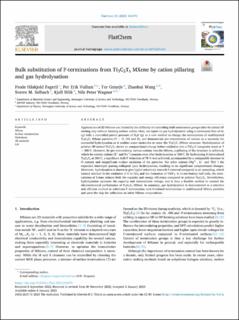| dc.contributor.author | Fagerli, Frode Håskjold | |
| dc.contributor.author | Vullum, Per Erik | |
| dc.contributor.author | Grande, Tor | |
| dc.contributor.author | Wang, Zhaohui | |
| dc.contributor.author | Selbach, Sverre Magnus | |
| dc.contributor.author | Wiik, Kjell | |
| dc.contributor.author | Wagner, Nils Peter | |
| dc.date.accessioned | 2023-02-15T07:14:49Z | |
| dc.date.available | 2023-02-15T07:14:49Z | |
| dc.date.created | 2023-01-15T15:37:33Z | |
| dc.date.issued | 2023 | |
| dc.identifier.citation | FlatChem. 2023, 38 100470-100479. | en_US |
| dc.identifier.issn | 2452-2627 | |
| dc.identifier.uri | https://hdl.handle.net/11250/3050879 | |
| dc.description.abstract | Applications of 2D MXenes are limited by the difficulty of controlling bulk termination groups after the initial HF etching step without forming surface oxides. Here, we report on gas hydrolysation using a continuous flow of Ar (g) with a controlled partial pressure of H2O (g) as a new method to change the terminations of multilayered Ti3C2Tx MXene particles (T = O, OH and F), and demonstrate pre-intercalation of cations as a necessity for successful hydrolysation as it enables water molecules to enter the Ti3C2Tx MXene structure. Hydrolysation of pristine HF-etched Ti3C2Tx shows no compositional change before oxidation into a TiO2/C composite starts at T > 300 ˚C. However, by pre-intercalating various cations into the MXene, a pillaring of the structure is achieved, which for certain cations (K+ and Na+) remains even after hydrolysation at 300 ˚C. By hydrolysing K-intercalated Ti3C2Tx at 300 ˚C, a significant bulk F reduction of 78 % was achieved, accompanied by a comparable increase in O content and insignificant surface oxidation of the particles. For other cations (Mg2+, Li+ and TBA+) the expanded interlayer spacing collapsed upon hydrolysation, resulting in no significant compositional changes. Moreover, hydrolysation is shown to give higher selectivity towards F removal compared to air annealing, which instead resulted in the oxidation of C to CO2 and the formation of TiOF2. In Li-ion battery half cells, the intercalation of K-ions reduces both the capacity and energy efficiency compared to pristine Ti3C2Tx. Nevertheless, hydrolysation increases the capacity and intercalation voltage, and is thus a feasible method to control the electrochemical performance of Ti3C2Tx MXene. In summary, gas hydrolysation is demonstrated as a selective and efficient method to substitute F terminations with O-related terminations in multilayered MXene particles and pave the way for utilisation on other MXene compositions. | en_US |
| dc.description.abstract | Bulk substitution of F-terminations from Ti3C2Tx MXene by cation pillaring and gas hydrolysation | en_US |
| dc.language.iso | eng | en_US |
| dc.rights | Navngivelse 4.0 Internasjonal | * |
| dc.rights.uri | http://creativecommons.org/licenses/by/4.0/deed.no | * |
| dc.title | Bulk substitution of F-terminations from Ti3C2Tx MXene by cation pillaring and gas hydrolysation | en_US |
| dc.title.alternative | Bulk substitution of F-terminations from Ti3C2Tx MXene by cation pillaring and gas hydrolysation | en_US |
| dc.type | Journal article | en_US |
| dc.description.version | publishedVersion | en_US |
| dc.source.pagenumber | 100470-100479 | en_US |
| dc.source.volume | 38 | en_US |
| dc.source.journal | FlatChem | en_US |
| dc.identifier.doi | 10.1016/j.flatc.2023.100470 | |
| dc.identifier.cristin | 2107123 | |
| dc.relation.project | Norges forskningsråd: 295864 | en_US |
| dc.relation.project | Sigma2: NN9264 | en_US |
| dc.relation.project | Norges forskningsråd: 275810 | en_US |
| cristin.ispublished | true | |
| cristin.fulltext | original | |
| cristin.fulltext | original | |


